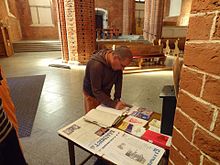Tripurari Swami
Swami Tripurari (Swami Bhaktivedanta Tripurari; IAST: Svāmi Bhaktivedānta Tripurāri), also known as Swami BV Tripurari or Tripurari Swami, is an American author, poet, and guru, described as "a prominent master in the Gaudiya Vaishnava lineage", and "one of the leading practitioners of Bhakti-yoga in the West."[1]
Sri Tridandi Swami Bhaktivedanta Tripurari | |
|---|---|
 Tripurari Swami in 2016. | |
| Other names | Swami BV Tripurari |
| Personal | |
| Born | Thomas Beaudry March 12, 1949 |
| Religion | Hinduism |
| Denomination | Vaishnavism |
| Lineage | Brahma-Madhva-Gaudiya Sampradaya |
| Sect | Gaudiya Vaishnavism |
| Other names | Swami BV Tripurari |
| Religious career | |
| Based in | California |
| Predecessor | A. C. Bhaktivedanta Prabhupada, B. R. Sridhara Dev-Goswami |
| Initiation | Diksa–1972, Sannyasa–1975 |
| Post | Guru, Sannyasi |
| Website | Sri Caitanya Sanga |
| Part of a series on |
| Vaishnavism |
|---|
 |
|
Holy scriptures
|
|
Sampradayas
|
|
Related traditions |
|
|
Biography
Tripurari Swami was born Thomas Beaudry in 1949 in Teaneck, New Jersey. He devoted his youth to the pursuit of transcendental knowledge and mystic experience. His lifetime of spiritual practice and teaching has brought him notice in spiritual circles around the world and earned the appreciation of scholars and practitioners alike. He has been described as helping "scholars... apprehend more clearly the dynamic nature of the Krsna consciousness movement."[2]
Tripurari Swami met his initiating guru, A. C. Bhaktivedanta Swami Prabhupada, in the spring of 1972.[3] Tripurari relates that he felt as though he had met a long-lost friend, as Prabhupada blessed him with his all-knowing glance. Over the years that followed, Prabhupada showered Tripurari with affection and repeatedly expressed his appreciation for Tripurari's selfless service and ability to inspire others. In 1974 Prabhupada instructed Tripurari in a widely circulated letter,[4] "So you organize freely. You are the incarnation of book distribution. Take the leadership and do the needful." Accordingly, Tripurari Swami has set an example of one who is independently thoughtful and capable of making an insightful literary contribution to the world.
Before accepting sannyasa in 1975, Tripurari Swami was known as Tripurari dasa.[5]
Shortly before Prabhupada's leaving this world, he suggested that, should the need arise, his students could receive further instruction from his "godbrother", B. R. Sridhara. Tripurari Swami was present when Prabhupada gave this instruction,[6] however, it was not until several years later, in the midst of the confusion that followed Prabhupada's departure,[7] that it would affect the course of Tripurari Swami's spiritual pursuit.
Tripurari Swami expresses his experience of hearing from and serving Sridhara Swami thus: "With the setting of the sun of the manifest pastimes of our beloved preceptor, Srila A. C. Bhaktivedanta Swami Prabhupada, the world became dark. Then suddenly in the shadows of the night the reflected light of the moonlike discourse of Srila B. R. Sridhara Deva Goswami flooded the path with new light and dynamic insight that illumined the inner landscape, leading me to the soul of Srila Prabhupada and Gaudiya Vaisnavism." The association and instructions of B. R. Sridhara Swami profoundly affected Tripurari Swami, and under his guidance, Tripurari Swami began initiating his own students in 1985.
Reviews
In 1998, Yoga Journal gave Tripurari Swami's Aesthetic Vedanta a one-paragraph review. Aesthetic Vedanta In 2002, Bhagavad Gita: Its Feeling and Philosophy, was reviewed in Yoga Journal,[8] and then by Arvind Sharma in 2005 for the Journal of Vaishnava Studies.[9]
Bibliography
- Rasa - Love Relationships in Transcendence, Mandala, 1995. ISBN 1-886069-10-7
- Ancient Wisdom for Modern Ignorance, Mandala, 1995. ISBN 1-886069-11-5
- Jiva Goswami's Tattva-Sandarbha: Sacred India's Philosophy of Ecstasy, Mandala, 1996. ISBN 1-886069-12-3
- Aesthetic Vedanta: The Sacred Path of Passionate Love, Mandala, 1998. ISBN 1-886069-14-X
- Bhagavad-gita: Its Feeling and Philosophy, Mandala, 2001. ISBN 1-886069-53-0
- "Bhagavad-gita: Seeing Nonviolence in the Violent Play of God." In Steven J. Rosen, ed., Holy War: Violence and the Bhagavad-gita, Deepak Heritage Books, 2002. ISBN 0-937194-44-1
- Form of Beauty, with B. G. Sharma. Mandala, 2005 (2nd edition). ISBN 1-932771-36-0
- Gopala-tapani Upanisad. Audarya, 2004. ISBN 1-932771-12-3
- Siksastakam of Sri Caitanya. Mandala, 2006. ISBN 1-932771-84-0
- Sacred Preface, Darshan Press, 2016. ISBN 9780997377309
References
- Rosen, Steven (2002), Holy war: violence and the Bhagavad Gita, Deepak Heritage Books
- Babhru Dasa 1999
- "Prabhupada Disciple database". Prabhupada.com. Retrieved January 20, 2010. (primary source)
- Prabhupada (November 12, 1974), Letter to Tripurari - Bombay
- Dasa, Riddha (2002). Mission in service of His Divine Grace. Visnu Garuda Books. ISBN 1-901593-01-0. Accessed from the Bhaktivedanta VedaBase, published by the Bhaktivedanta Archives "In March 1975, Pusta Krsna Swami traveled to India for the Mayapura festival. (...) Before I could go I had to gain the approval of my authority, Tripurari dasa, the leader of our BBT travelling party. (...) One week later, however, while in Vrndavana, after having received sannyasa initiation from Srila Prabhupada, the now Swami Tripurari finally conceded that it would be a great service opportunity for me to travel to South Africa as a BBT sankirtana representative..."
- Ekstrand & Bryant 2004, pp. 187
- Visnu, Swami. "The guardian of devotion: disappearance and rejection of the spiritual master in ISKCON after 1977".
- Mixed Media, Yoga Journal
- Arvind Sharma review
External links
- Sri Caitanya Sanga, also known as Audarya, is a monastery he established.
- The Harmonist publishes articles relevant to Gaudiya Vaishnavism under his editorial supervision.
- Srila Bhakti Raksak Sridhar Dev-Goswami Maharaj - a hagiography from the organization he founded, Sri Chaitanya Saraswat Math.